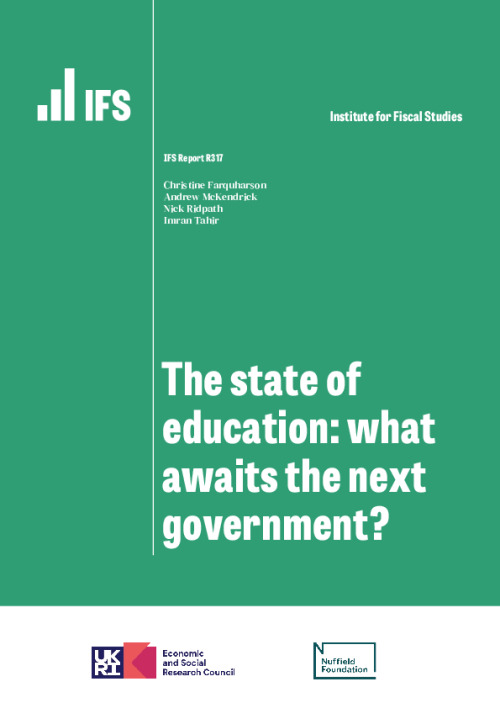Executive summary
Key findings
1. England is one of the best-performing countries in terms of school-age attainment. Over the past decade, the literacy and numeracy skills of 15-year-olds in England have improved significantly relative to other high-income countries. While England is middle-of-the-pack on inequalities, among the OECD only Canada, Estonia, Ireland and Japan manage to deliver both stronger average attainment and lower inequality than England.
2. The COVID-19 pandemic has reduced performance – reversing a decade of progress in reading. However, the extent of the decline is in line with other developed countries (and less severe than in other UK nations), and England still has higher levels of performance than the G7 average. For the rest of the UK nations, the picture is much worse – Scotland, Wales and Northern Ireland all saw their worst-ever PISA maths performance in 2022, and the latter two also recorded their worst scores in reading.
3. There are significant inequalities at all stages of education. Even at the start of school, only half of pupils eligible for free school meals achieve a good level of development, compared with 72% of their less disadvantaged peers. Pupils eligible for free school meals are three times less likely to attend one of the most selective higher education institutions.
4. Despite decades of policy attention, many education inequalities have persisted over time. There has been virtually no change in the gap between children from more and less disadvantaged backgrounds in GCSE attainment over the past 20 years. While GCSE attainment has been increasing over time, 16-year-olds who are eligible for free school meals are still around 29 percentage points less likely to earn good GCSEs than their less disadvantaged peers.
5. The number of children on an Education, Health and Care plan – the highest tier of support for special educational needs – has risen by 60% since 2016. This increase is even more striking since there is evidence of schools and local authorities rationing support; 98% of appeals are successful at tribunals. Not unrelatedly, the rise in EHC plans has been faster among less disadvantaged families.
6. Since the COVID-19 pandemic, absenteeism has increased by almost two-thirds. On average, pupils now miss 14 days of school per year, rising to 21 days for disadvantaged pupils. 37% of disadvantaged pupils are now recorded as ‘persistently absent’, meaning they miss at least a day of school per fortnight on average.
7. The COVID-19 pandemic also drove a substantial worsening in girls’ mental health: in 2022–23, 30% of girls aged 10–15 met the threshold for abnormally high emotional and behavioural difficulties, up 5 percentage points since 2019–20. NHS research found that the share of 8- to 16-year-olds with a probable mental disorder rose from 12.5% in 2017 to 20% in 2023. After hovering between 4% and 6% for over a decade, the share of young people who report strongly disliking school doubled to 10% in 2022.
1. Introduction
Improving the educational outcomes of children and young people is an objective of political parties of all colours. This is important not only for young people themselves, but also for the economy – a better-educated workforce is a more productive workforce. The government currently spends £116 billion on education in the UK, making it the second-largest element of public service spending after health (Drayton et al., 2023). Over the course of this parliament, spending on schools has increased as per-pupil spending has returned to its 2010 level (Sibieta, 2024a). But, at the same time, schools have faced an unprecedented set of challenges due to the COVID-19 pandemic and the cost-of-living crisis. These challenges have cast a long shadow that will impact schools and young people beyond this parliament.
In this report, we analyse the current state of the education system in England and set out the key challenges that the next government will inherit. This is not just a tale of despair. Compared with many other developed countries, England’s education system does well in terms of student performance, and young people’s skills have held up better through the COVID-19 pandemic than in many comparable countries.
But there are substantial inequalities in attainment at every stage of education. Many of these inequalities have persisted for decades, but new issues have also emerged in recent years. Schools have seen a sharp increase in the number of pupils with special educational needs, a rise in absenteeism, and growing emotional and behavioural difficulties among young people. All the main political parties recognise these challenges and tackling these issues will be high on the agenda of the next Education Secretary.
2. How does England’s educational performance compare with other countries?
Over the last 10 to 15 years, literacy and numeracy skills in England have improved significantly relative to other UK nations, and relative to other high-income countries. As Figure 1 shows, prior to the pandemic England steadily improved its performance in reading in the PISA tests (which are taken by 15-year-olds across the OECD), while maths scores jumped up in 2018. In 2018, England’s scores eclipsed the G7 average and stood comfortably above Northern Ireland, Scotland, Wales and the wider OECD average. This is a significant achievement, particularly given a squeeze on school spending through much of this period, and speaks to the success of teachers, schools and policymakers in improving the productivity of England’s education system (Sibieta, 2024a).
The pandemic reversed a significant amount of this progress. School closures, social distancing and quarantining caused huge disruption for children’s education, with much bigger impacts for the poorest (Blundell et al., 2020; Cattan et al., 2021). In Autumn 2020, primary school pupils had lost around 2 months’ expected progress in reading and 3½ months’ progress in maths (National Audit Office, 2023).
However, the English school system adapted as the pandemic progressed, and by Summer 2021 pupils had made up roughly half of this ‘lost learning’. Secondary school pupils remained around a month behind expectations in reading, with pupils eligible for free school meals losing twice as much as their better-off peers (Renaissance Learning and Education Policy Institute, 2022).
The impacts of the pandemic are also visible in PISA data: reading and maths scores in 2022 were around 10 points lower than in 2018 (equivalent to 10% of a standard deviation), undoing a decade’s worth of progress in reading and reversing recent improvements in maths scores. Results in the PISA science test were an area of disappointment for England, with the declining trend that started in 2015 continuing and all four UK nations recording their worst-ever scores.
Despite a significant amount of lost learning, England’s post-COVID performance compares favourably with other countries. The fall in scores is comparable to that of the average of the rest of the G7, such that scores in England remain above the average for the rest of the G7 in both maths and reading. For the rest of the UK nations, the picture is much worse – in maths, in particular, the decline in the other UK nations resulted in their worst-ever performance in PISA.1 Wales and Northern Ireland also saw their worst scores ever in reading.
How does the disadvantage gap in educational performance in England compare with other countries?
In 2022, children from the least advantaged fifth of households in England scored 95 points lower on PISA literacy tests, and 90 points lower in numeracy, than their peers from the most advantaged fifth of families. This difference is similar in size to the difference between England’s average performance and that of Colombia, which has the lowest score of any OECD country.
Even so, as Figure 2 shows, England sits squarely in the middle of the pack in terms of inequality: much less equal than Wales, Northern Ireland, Canada or Estonia, but more equal than Scotland, Germany, France and the US. On this measure, educational inequalities in Wales are the lowest of all OECD countries. England sits much closer to the top of the OECD in terms of its overall performance – it is higher than the three other UK nations but lower than the likes of Japan.
Considering both the level of attainment and the equality of performance together, there are only a handful of countries that are both better performing and more equal than England (in the top left of Figure 2). Canada, Estonia, Ireland and Japan match or exceed England’s overall performance and have lower levels of inequality too. By contrast, Wales is more equal than England – but this smaller gap between the least and most advantaged comes at the expense of overall performance, with lower absolute performance at both the top and the bottom of the distribution.2
3. The stubbornness of educational inequalities
England has average levels of educational inequalities according to PISA, and the level of inequality within the education system has been a long-standing concern for policymakers. Despite decades of policy attention, inequalities in education have been exceptionally persistent. As Figure 3 shows, despite significant increases in the proportion of pupils achieving key GCSE benchmarks, the performance gap between pupils eligible for free school meals and their more advantaged peers has remained essentially unchanged at between 26 and 29 percentage points.
Tuckett et al. (2023) construct a different measure of the ‘disadvantage gap’ by converting the difference in GCSE attainment between students into a measure of how many months of learning disadvantaged students are behind other students. According to this measure, there was a slight decline in socio-economic difference between 2011 and 2017 as the GCSE disadvantage gap fell by 1.8 months. However, since 2017, progress in closing the gap seems to have stalled, and the disadvantage gap has now returned to its largest level since 2012.
Differences in attainment are also stubbornly persistent at each age. Figure 4 shows the percentage of pupils in England who achieved key educational benchmarks at age 5 (the first year of school), age 7 (the end of Key Stage 1), age 11 (the end of primary school), age 16 (GCSEs) and age 19 (Level 3 attainment), as well as progression to higher education. Disadvantage gaps start early: while only 52% of children eligible for free school meals are recorded as having a good level of development at age 5, 72% of children from better-off families meet this benchmark.
These gaps persist, broadly similar in size, throughout the education system. By the end of primary school, fewer than half of disadvantaged pupils are meeting expectations in reading, writing and maths. The gap is even larger at GCSE, where 43% of pupils eligible for free school meals earn a grade 4 in English and maths, compared with 72% of their more affluent peers.
These differences in attainment during the school years translate into differences in progression beyond compulsory schooling. Just over a quarter (29%) of pupils eligible for free school meals at age 15 are in higher education at age 19, compared with almost half (49%) of their better-off peers (Department for Education, 2023). When looking specifically at the most selective higher education institutions, attendance rates are three times higher for pupils who were not eligible for free school meals at school.
4. What are the key emerging challenges facing schools?
In addition to the long-standing challenges of educational inequalities, new challenges are emerging for the school system in the wake of the COVID-19 pandemic.
Special educational needs and disabilities
One of the costliest challenges facing schools is the 28% increase in the number of children receiving any type of support for special educational needs and disabilities (SEND) over the last decade. While the high-needs budget accounts for just 15% of total school spending, a £3.5 billion increase in spending since 2015 has by itself taken up almost half of the total increase in school spending over that period (Sibieta, 2024a).
The growth in children receiving support for SEND has been almost entirely driven by an increase in Education, Health and Care (EHC) plans, which are intended for those with the highest level of need. Across primary and secondary schools, the number of children receiving an EHC plan has risen from 2.8% to 4.3% of all pupils – a 50% increase since 2016. This represents a 60% increase in the absolute number of pupils (Department for Education, 2023). Much of the rise came during and after the COVID-19 pandemic, with around 95,000 more pupils receiving an EHC plan in the 2022/23 academic year than three years earlier.
But, as Figure 5 shows, while more disadvantaged children are much more likely to be receiving EHC plans, the increase over the last few years has been greater among those from less disadvantaged backgrounds.
The disproportionate increase among those from less disadvantaged backgrounds reflects, in part, efforts by schools and local authorities to ration support in a bid to hold down costs (Booth, 2023). The number of appeals to SEND tribunals – which are almost exclusively about EHC plans – has almost trebled to over 14,000 per year. Despite this growth, tribunal appeals now have a 98% success rate – meaning that many families and children who meet the criteria for support are initially being turned down. In turn, this means that families with the time, information and resources to pursue an appeal on their child’s EHC assessment are more likely to secure a plan. Children from more disadvantaged groups, who might have less ability to appeal, may well have experienced a similar increase in need for additional support, which is not being met because these children are not able to access EHC plans.
Absences
Another key post-COVID challenge for schools has been an extraordinary spike in absences: relative to the pre-pandemic period, the absence rate has jumped from 4.6% to 7.4%. This means that the average pupil now misses over 14 days of schooling per year, with that figure rising to 21 days for children from disadvantaged backgrounds.
Figure 6 shows the rise in absences and breaks this down into two categories – severe absence (children who are absent more than 50% of the time) and persistent but not severe absences (children who are absent between 10% and 50% of the time). While severe absence is rare, the number of severely absent children has more than doubled since the pandemic. This has played a significant role in increasing overall absenteeism and suggests a worrying increase in the number of children with very limited contact with the education system, who come disproportionately from more disadvantaged backgrounds.
Figure 6 also shows that it has become much more common for children to miss more than one day of school per fortnight, known as persistent absence (which includes severe absence). For students not eligible for free school meals, the proportion who are persistently absent has doubled since the pandemic from 8% to 16%. For students from more disadvantaged backgrounds, rates of persistent absence have reached a staggering 37%, meaning that almost four in ten of these children miss at least half a day each week on average – up from 23% in 2018/19. Other countries have faced problems of a similar scale: in the US, the number of persistently absent students has increased to 31%, double what it was prior to the pandemic (White House, 2024).
As was true before the pandemic, more than half of absences are due to illness. Even excluding absences specifically due to COVID-19, absences due to illness spiked in 2021–22, when 4.4% of school days were lost to illness. But, unlike other forms of absence, illness-related absences are starting to fall, reaching 3.7% in 2022–23 (compared with a pre-pandemic rate of around 2.5%). Besides illness, there have been increases in absences across a wide range of explanations, with both authorised and unauthorised absences increasing.
Mental health and behaviour
The pandemic has also resulted in a step change in young people’s mental health, which can affect both patterns of absence and the level of behaviour in the classroom environment. After more than a decade of hovering between 4% and 6%, the share of young people aged 10–15 who reported that they strongly disliked their school hit 10% in 2022 (based on data from Understanding Society).
This seems to be part of a wider worsening in young people’s mental health. Figure 7 plots the total level of emotional and behavioural difficulties self-reported by 10- to 15-year-olds in the UK using the Strengths and Difficulties Questionnaire. A higher score indicates more emotional and behavioural difficulties.
Between 2018–19 and 2022–23 (the latest year for which data are available), there has been a substantial increase in emotional and behavioural difficulties among young people. This is entirely driven by girls: the average SDQ score for girls rose from 11.6 in 2018 to 12.8 in 2022, peaking at 13.3 during the COVID-19 pandemic.
Scores of 17 or more on this test are considered abnormal; the share of girls reaching this threshold rose from 15% in the early 2010s, to 25% right before the pandemic, to 30% in 2022–23. Similar data collected by the NHS indicate that 20% of 8- to 16-year-olds have a probable mental disorder, markedly up from the 12.5% seen in 2017 (NHS Digital, 2023). Rates are even higher among 17- to 19-year-olds.
The increase in emotional and behavioural difficulties is driven by two categories in particular – hyperactivity and emotional difficulties. This suggests that children themselves are struggling with two different problems – an increase in behavioural difficulties and a decline in emotional well-being.
Increases in behavioural difficulties can also be seen in wider statistics. Since the pandemic, the number of children suspended from school in a term has increased by 25% (Department for Education, 2024b). The total number of suspensions, and the number of days missed due to suspension, have increased by even more: not only are more children being suspended, but those who are being suspended are being suspended more often and for longer.
A rising profile of poor mental health does not seem to be unique to the UK. In general, international comparisons of mental health are difficult as there is no single cross-country measure of mental health, and so any international comparison must be taken with a pinch of salt. However, the evidence that is available does suggest that young people in other countries are also experiencing declining mental health. A recent UNICEF study (2024) provides evidence of declining life satisfaction among 15-year-olds across Europe; in the US, Lin, Parker and Horowitz (2024) find worsening behaviour in schools in the US, where 80% of teachers report that the pandemic had a very or somewhat negative ‘lasting impact ... on students’ behavior, academic performance and emotional well-being’. An OECD study (2022) looking at mental health among older children and young adults also found that mental health problems doubled during the pandemic.
5. The next government’s inheritance
The next government will inherit an education system that produces high levels of student achievement. The performance of 15-year-olds in reading and mathematics is well above the OECD average. But there are also fundamental challenges. At every stage of education, children from less advantaged backgrounds perform significantly worse. This is not an issue unique to England, and very few countries achieve higher performance while maintaining greater equality. Yet the scale of many of these inequalities – such as the disadvantage gap in GCSE attainment – has changed little in the past 20 years, which underlines the fact that there are no easy solutions.
During this parliament, schools have also faced unprecedented challenges due to the COVID-19 pandemic and rising inflation. As in all countries, the pandemic has contributed to significant learning losses – a decade of progress in reading has been reversed. The impact of the pandemic is not just evident in test scores. Since the COVID-19 pandemic, there has been a worrying increase in absenteeism and a rise in behavioural problems and mental health challenges. This, combined with longer-term trends such as an increase in the number of pupils with special educational needs, is creating significant pressures in the education system.
The next government should build on what is working well while addressing these specific problems. Tackling these challenges will be essential to both reducing inequality and improving economic efficiency. As recent decades have shown, there are no simple solutions. But developing an education system that supports all children to reach their full potential is an enormous prize, and one that the next government should strive to achieve.














